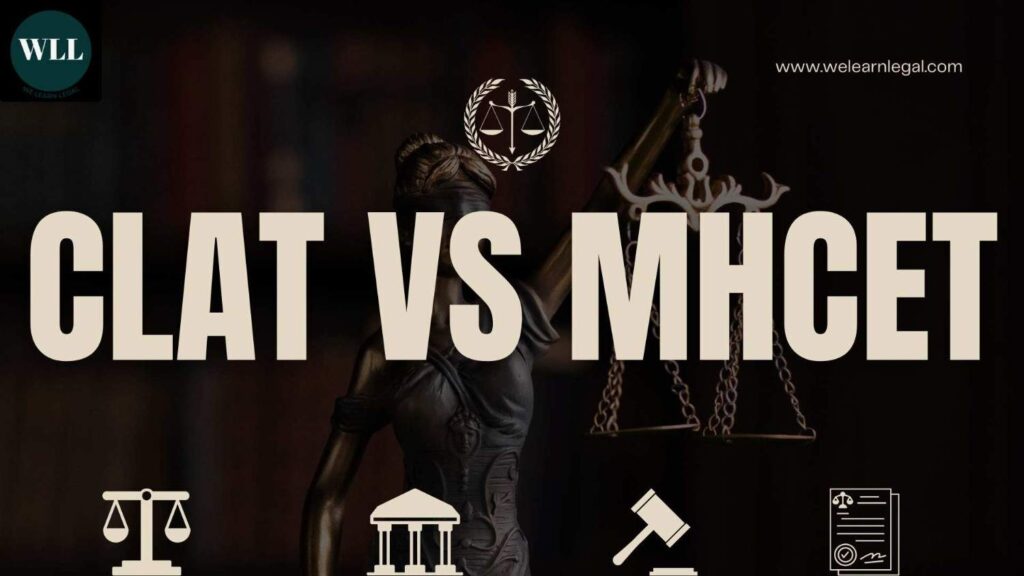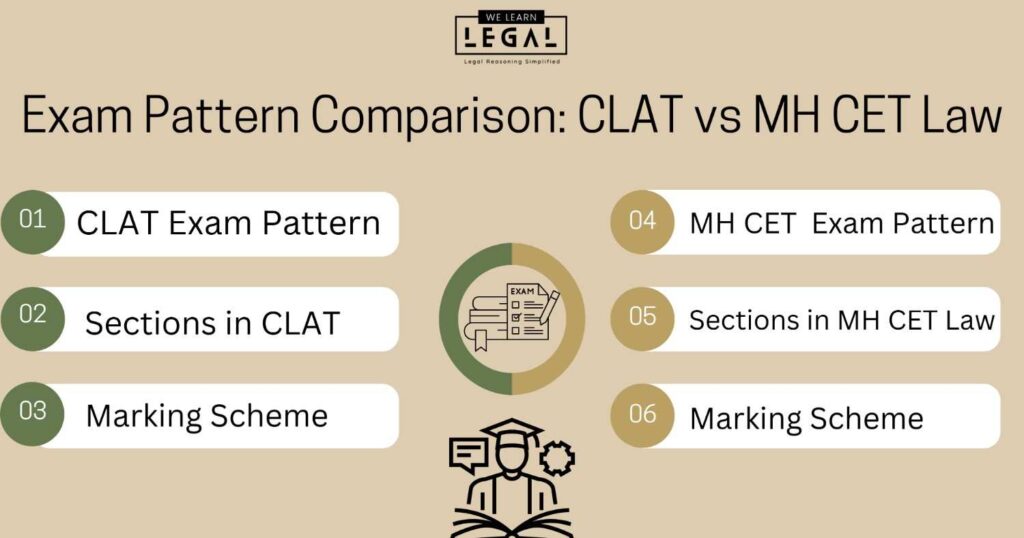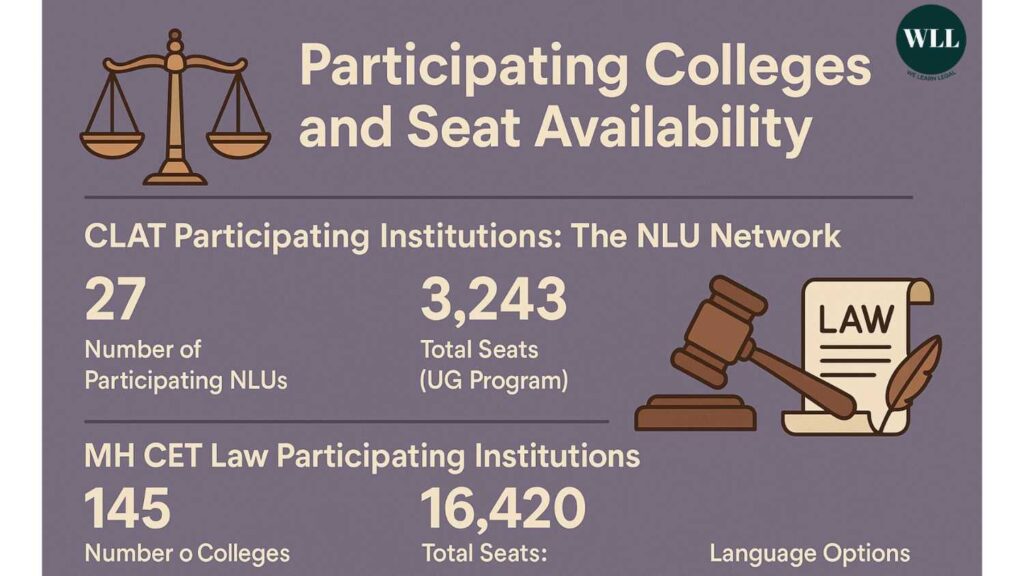In the grand courtroom of career choices, the verdict on “which law entrance exam to choose?” is not always clear. Imagine a student in Class 12, somewhere in Nagpur or Noida, torn between dreams of arguing cases like Harish Salve and a silent wish to be the next big NLU graduate. The Indian legal profession, often glorified in movies like Jolly LLB and Pink, is evolving – and so is the path to enter it. This brings us to the popular debate of CLAT vs MH CET, a crucial decision that shapes the journey into India’s top law schools and ultimately, the legal profession itself.
The question isn’t just “Do I want to become a lawyer?” but “Which gateway should I take to begin that journey?” In India, two significant law entrance exams dominate the student landscape: CLAT (Common Law Admission Test), a prestigious national-level exam that opens doors to the revered NLUs, and MH CET Law (Maharashtra Common Entrance Test for Law), a more regional yet robust exam designed for entry into top colleges across Maharashtra.

Take the case of Ayushi, a bright student from Pune who aspires to practice corporate law. Her cousin, Raghav, cracked CLAT and now studies at NALSAR Hyderabad, while she debates whether MH CET Law would be a more realistic and affordable option. Their dinner table conversations sound like courtroom debates—national reach versus local access, negative marking versus none, five-year versus three-year options.
In a country where news headlines oscillate between the latest constitutional verdict and a celebrity legal battle, law as a career has gained both glamour and gravity. But choosing the right entrance exam isn’t just about reputation—it’s about fit. Which exam matches your strengths, your goals, your geography?
This blog breaks down everything you need to know to make that decision—exam pattern, syllabus, difficulty, participating colleges, career scope, and more. Whether you’re aiming for the legal elite or looking for practical access to a respected law college, this guide will help you weigh your options.
So, if you’re wondering whether your destiny lies in an NLU library or the lecture halls of GLC Mumbai, read on. The judgment might just surprise you.
Why Choosing the Right Law Entrance Exam Matters
Choosing a law entrance exam isn’t like picking a random movie on Netflix—it’s more like selecting the right courtroom to plead your first big case. The decision you make at this point can shape your academic journey, your exposure to opportunities, and in many ways, the foundation of your legal career.
In India, where every competitive exam feels like a mini version of the UPSC in terms of stress and strategy, law aspirants face a unique dilemma. The legal profession is gaining prominence not just because of the allure of courtroom dramas or high-paying law firms, but because it’s increasingly tied to real social change. Remember how the Ayodhya Verdict, Section 377 decriminalization, or even the Right to Privacy case made headlines? These weren’t just legal milestones—they were reflections of how law graduates today are becoming the defenders of democracy and justice in its most raw, impactful form.
But to get to that courtroom—real or symbolic—you need the right entry pass. That’s where exams like CLAT and MH CET Law come in.
On one side, you have CLAT (Common Law Admission Test), a prestigious national-level exam that can unlock the gates to the top National Law Universities (NLUs) in India. For many, it’s the IIT-JEE of the law world. Students from Delhi, Bengaluru, Jaipur, and beyond spend months—even years—preparing for this exam, hoping to earn a seat at places like NLSIU Bangalore or NALSAR Hyderabad.
On the other side stands MH CET Law, the state-level law entrance exam of Maharashtra. It might not carry the national glamour of CLAT, but it commands immense respect within the state. Institutions like Government Law College, Mumbai or ILS Pune have produced judges, bureaucrats, and lawyers who’ve left their mark on Indian legal history. For students who prefer to study closer to home, in a more affordable and localized setup, MH CET Law is not a compromise—it’s a calculated choice.
So, what’s the catch? Well, the two exams differ in more than just location or prestige. Their patterns, difficulty levels, eligibility criteria, and even career outcomes can vary widely. And that’s where this blog comes in.
We’re here to break down both CLAT and MH CET Law—side by side—so that whether you’re from Bhopal or Bandra, Kanpur or Kolhapur, you’ll walk away with clarity. No more confusion. No more blind choices. Just the facts, comparisons, and insights you need to make an informed, confident decision.Because in the world of law, the right question often leads to the right judgment. And today, that question is: CLAT or MH CET Law—Which exam is right for you?
Understanding the Exams: CLAT and MH CET Law
Before you start solving mock papers or comparing cut-offs, it’s essential to understand what these two exams—CLAT and MH CET Law—actually are. Think of this as reading the case file before presenting your arguments. You need the facts, the context, and a little bit of insider knowledge to see which test aligns best with your future.
What is CLAT?
CLAT, short for the Common Law Admission Test, is often referred to as the gateway to India’s premier law institutions—the National Law Universities (NLUs). If you’ve ever heard of colleges like NLSIU Bangalore or NALSAR Hyderabad, know that CLAT is the reason they have a reputation for excellence.
This exam is conducted by the Consortium of National Law Universities, a body formed by the NLUs themselves to ensure uniformity and fairness in the admission process. Each year, thousands of students across India apply for CLAT in the hope of making it into one of the 24 participating NLUs.
But CLAT isn’t just about getting into a good college. It’s a symbol—like the CAT is for MBA aspirants or NEET for medical students. Cracking CLAT means you’ve cleared a national-level hurdle, proving your aptitude in critical thinking, language, legal reasoning, and current affairs.
CLAT offers entry into:
- The 5-year Integrated LLB program (BA LLB, BBA LLB, etc.)
- The 1-year LLM (Master of Laws) for graduates
What makes CLAT unique is its focus on comprehension-based questions that test your ability to analyze and interpret rather than just memorize. It’s an exam that rewards students who understand context—a skill every good lawyer must master.
In a way, preparing for CLAT is like preparing for a courtroom debate. It’s not just about what you know—it’s about how you apply what you know under pressure.
What is MH CET Law?
Now, let’s turn to a more regional but equally significant player: MH CET Law, short for Maharashtra Common Entrance Test for Law. If CLAT is the national stage, MH CET Law is the state champion—a powerful entrance test that opens the doors to some of Maharashtra’s finest law institutions.
Conducted by the State Common Entrance Test Cell, Maharashtra, this exam is designed for students who are looking to pursue law closer to home—particularly in cities like Mumbai, Pune, Nagpur, and Aurangabad.
And here’s the best part: unlike CLAT, MH CET Law offers not just a 5-year integrated LLB, but also a 3-year LLB program for students who decide to pursue law after graduation. This makes it an excellent option for students from non-law backgrounds, or those who make a late but firm choice to enter the legal field.
MH CET Law opens the gates to top colleges like:
- Government Law College (GLC), Mumbai
- ILS Law College, Pune
- Symbiosis Law School, Nagpur (for CET-based admission)
It’s a computer-based test, typically conducted in English and Marathi, which makes it more accessible for local students. And while it might not carry the national prestige of CLAT, it holds immense value in the legal circles of Maharashtra.
Picture this: you’re a student from Nashik or Thane, dreaming of a legal career but unsure about going national. MH CET Law offers a more affordable, less competitive, and locally reputed route that could lead you to a fulfilling practice, judiciary preparation, or even a civil service career.
In short, CLAT and MH CET Law represent two very different, yet equally valid, entry points into the world of law. One is nationally recognized, competitive, and intense. The other is regionally respected, practical, and accessible.Choosing between them is less about which is “better,” and more about which one fits your goals, your strengths, and your story.
Exam Pattern Comparison: CLAT vs MH CET Law
If preparing for a law exam is like training for a big match, then understanding the exam pattern is your playbook. Whether you’re aiming for the national league with CLAT or targeting the state circuit via MH CET Law, you must know what’s coming your way. After all, even the best players need to know the rules of the game before they step on the field.Let’s break it down—section by section, mark by mark.

CLAT Exam Pattern: The National Arena
Think of CLAT as the Ranji Trophy of law exams, but with national stakes. It’s conducted offline, which means you’ll be answering on paper—yes, that old-school pen-and-paper format where bubbling in the right circle still counts!
Here’s what the CLAT paper looks like:
- Mode: Offline (Pen and Paper)
- Duration: 2 hours (120 minutes of pure focus)
- Total Questions: 120
- Total Marks: 120
- Type: Objective (Multiple Choice Questions)
Sections in CLAT:
- English Language – Not just vocabulary; expect passages with deep comprehension questions.
- Current Affairs including General Knowledge – From Chandrayaan-3 to G20 summits and Nobel Prize winners.
- Legal Reasoning – Principle-fact questions that test your application of logic to legal scenarios. Think Section 300 IPC meets Sherlock Holmes.
- Logical Reasoning – Critical thinking, puzzles, and arguments.
- Quantitative Techniques – Graphs, percentages, and basic data interpretation.
Marking Scheme:
- +1 for every correct answer
- -0.25 for every incorrect answer
This negative marking makes CLAT a bit like a courtroom cross-examination—you can’t bluff your way through. Every answer must be chosen with care.
MH CET Law Exam Pattern: Maharashtra’s Legal Gateway
Now, let’s turn to MH CET Law, the digital sibling in this exam family. If CLAT is pen-and-paper, MH CET is all about screens and speed. Conducted online, this computer-based test is popular among students from Maharashtra who prefer a familiar testing environment with less national-level competition.
Here’s how MH CET Law stacks up:
- Mode: Online (Computer-Based Test)
- Duration: 2 hours
- Total Questions: 150
- Total Marks: 150
- Type: Objective (Multiple Choice Questions)
Sections in MH CET Law:
- Legal Aptitude and Legal Reasoning – Expect legal principles, but less analytical depth than CLAT. Think straight facts and basic logic.
- General Knowledge with Current Affairs – Similar to CLAT but less passage-based; more one-liners and direct questions.
- Logical and Analytical Reasoning – Coding-decoding, number series, assumptions.
- English – Grammar, comprehension, vocabulary.
- Basic Mathematics (only for 5-year LLB) – Time-Speed-Distance, Percentages, Averages, etc.
Marking Scheme:
- +1 for each correct answer
- No negative marking
This single factor—no negative marking—makes MH CET Law less risky for guesswork. If CLAT is a high-stakes poker game, MH CET Law is more like a safe round of rummy—less intense, but still rewarding for sharp minds.
Quick Snapshot: CLAT vs MH CET Law Pattern
| Feature | CLAT | MH CET Law |
|---|---|---|
| Mode | Offline (Pen & Paper) | Online (Computer-Based) |
| Duration | 2 Hours | 2 Hours |
| Total Questions | 120 | 150 |
| Sections | 5 (including Quantitative) | 5 (Maths only in 5-year program) |
| Marking Scheme | +1 / -0.25 for wrong answers | +1 / No negative marking |
| Question Style | Comprehension-heavy | Direct and objective |
| Risk Factor | Higher (due to negative marking) | Lower (you can attempt all!) |
Syllabus Breakdown: What Do You Really Need to Study?
Understanding the syllabus of any entrance exam is like reading the bare act before drafting your argument—it gives you clarity, confidence, and control. If you’re a law aspirant standing at the crossroads of CLAT and MH CET Law, knowing what each exam tests you on will help you match your strengths with the right path.
Let’s unpack the syllabus for both exams and see how they differ not just in topics, but in thinking style.
CLAT Syllabus Highlights: Deep Thinking Over Rote Learning
If CLAT were a movie, it would be an intense courtroom drama—layered, intellectual, and full of twists. The syllabus is designed to test how well you comprehend, analyze, and apply information—very much like what lawyers do in real life.
Here’s what to expect:
Comprehension-Based Focus Across All Sections
CLAT is not about mugging up facts or solving 20 math sums per day. Every section (including English, GK, and Logical Reasoning) is structured around passages followed by questions. This means you need to read fast, think clearly, and choose smart.
Legal Reasoning
Forget Latin maxims or case laws from the start. CLAT’s legal reasoning doesn’t demand prior legal knowledge. Instead, it gives you a legal principle (like “Every person has the right to life”) and a factual situation, and you have to apply the principle logically. Think of it as playing judge in a simplified courtroom.
Example: Principle: A person who causes harm to another due to negligence is liable.
Fact: A shopkeeper leaves water on the floor, a customer slips and fractures her arm.
Question: Is the shopkeeper liable?
This type of analytical skill is crucial in law school and beyond.
Quantitative Techniques
Don’t panic—this isn’t JEE-level math. The Quant section focuses on:
- Averages, Ratios, Percentages
- Interpreting Graphs and Tables
- Basic Word Problems
It’s all about using basic math to interpret data in a legal or logical context.
MH CET Law Syllabus Highlights: Crisp, Direct, and Traditional
MH CET Law feels more like a standard competitive exam—more questions, shorter passages, and direct answers. If CLAT is a long-form essay, MH CET is a multiple-choice quiz show.
Here’s the subject-wise breakdown:
Legal Aptitude and Reasoning
This is where MH CET’s legal questions shine. They include:
- Legal propositions (e.g., “No person shall be punished for the same offence twice”)
- Fact-based conclusions (applying legal rules)
- General legal awareness (like Constitutional articles or landmark judgments)
Example:
Which Article of the Constitution deals with the Right to Education?
Answer: Article 21A
This section combines static legal knowledge with basic application, unlike CLAT’s comprehension-heavy approach.
General Knowledge and Current Affairs
This includes:
- Static GK: Indian Polity, History, Geography, Awards, Important Days
- Current Affairs: Sports, Government Schemes, Appointments, International Events
The questions here are direct—no passages. So if you read newspapers like The Hindu, Indian Express, or follow UPSC-style monthly magazines, you’re golden.
Logical and Analytical Reasoning
Expect:
- Puzzles, Blood Relations, Syllogisms
- Number and Letter Series
- Assumptions and Conclusions
This section is straightforward and scoring if you’ve practiced well.
English Language
Basic grammar, comprehension passages, vocabulary-based questions:
- Synonyms/Antonyms
- Fill in the blanks
- Spotting errors
- Para jumbles
Unlike CLAT, the English here is more rules-based than analysis-based.
Basic Mathematics (for 5-year LLB only)
This includes:
- Time & Work
- Speed & Distance
- Profit & Loss
- Percentages, Averages, SI/CI
And the best part? No scary surprises—all topics are from 10th-grade math.
Key Takeaway: Choose Based on Your Strengths
| Feature | CLAT | MH CET Law |
|---|---|---|
| Style of Questions | Passage-based, comprehension-heavy | Direct, MCQ-style questions |
| Legal Reasoning | Principle + Fact based, no legal knowledge | Proposition-based + general legal awareness |
| Quant/Maths | Data Interpretation, charts | Basic arithmetic (only for 5-year LLB) |
| GK & Current Affairs | Passage-style, analytical | One-liner factual questions |
| Ideal For | Students good at reading & analysis | Students good at factual recall & speed |
Consider these tips:💡
- If you’re unsure, prepare for both CLAT and MH CET simultaneously — their syllabi overlap in many areas, giving you a strategic advantage without doubling your effort..
👉 Check out our detailed syllabus guide here:
Eligibility Criteria: Can You Appear for These Exams?
Before you start your preparation journey, let’s get one thing straight: Are you even eligible to appear for the exam you’re dreaming of? Because just like in any legal case, you need standing to present your argument—similarly, you need to meet the eligibility criteria before you can sit for CLAT or MH CET Law.
Thankfully, both exams are fairly inclusive and cater to a wide pool of aspirants. But there are a few key differences you should know.
CLAT Eligibility: The National Doorway
The Common Law Admission Test (CLAT) is designed for students seeking admission to 24 National Law Universities (NLUs) across India. The eligibility criteria are simple but strict—no compromises on marks or documents.
For 5-year Integrated LLB Program (UG CLAT)
- You must have completed 10+2 or equivalent from a recognized board.
- Minimum marks required:
- General/OBC/PwD/NRI/PIO/OCI: 45%
- SC/ST: 40%
- General/OBC/PwD/NRI/PIO/OCI: 45%
- Students appearing in their Class 12 board exams are also eligible to apply, but they must produce proof of qualification at the time of admission.
Age Limit?
- There is no upper age limit to appear for CLAT.
- So, whether you’re a 17-year-old Class 12 student or someone restarting your career path, CLAT welcomes all—as long as you meet the marks criteria.
Example:
Ritika from Delhi, currently in Class 12, wants to study at NLU Jodhpur. As long as she clears her board exams and scores above 45%, she’s eligible to appear for CLAT. Age won’t hold her back.
MH CET Law Eligibility: Two Routes, One Goal
The Maharashtra Common Entrance Test for Law (MH CET Law) is a bit more flexible, offering two distinct programs: one for school students (5-year LLB), and one for graduates (3-year LLB). This dual option makes it accessible to a wider audience.
For 5-year Integrated LLB Program
- Must have completed 10+2 or equivalent.
- Minimum marks required:
- General category: 45%
- SC/ST/OBC from Maharashtra: 40%
- General category: 45%
- Final-year 12th students can apply provisionally.
For 3-year LLB Program
- Must have completed graduation (in any stream) from a recognized university.
- Minimum marks required:
- General category: 45%
- SC/ST/OBC from Maharashtra: 40%
- General category: 45%
- Students in their final year of graduation can also apply.
Age Limit?
- Again, no upper age limit—you can pursue law at 18, 28, or even 38.
Example:
Akshay, a B.Com graduate from Pune University, is now considering law. He doesn’t want to move out of Maharashtra, and he prefers local colleges. MH CET Law (3-year LLB) is tailor-made for him.
Key Differences at a Glance
| Criteria | CLAT (5-Year LLB) | MH CET Law (5-Year & 3-Year LLB) |
|---|---|---|
| Academic Requirement | 10+2 with minimum marks | 10+2 for 5-Year / Graduation for 3-Year |
| Minimum % Required | 45% Gen / 40% SC-ST | Same (with relaxation for Maharashtra quota) |
| Final Year Eligible? | Yes | Yes |
| Age Limit | No upper age limit | No upper age limit |
| Course Options | Only 5-Year LLB | 5-Year and 3-Year LLB |
| Ideal for | Class 12 students looking for top NLUs | Both freshers and graduates in Maharashtra |
Consider these tips:💡
- If you’re sure about law after Class 12 and want a national-level career, go for CLAT (5-year LLB).
- If you’re entering law a bit later or want to stay in Maharashtra, MH CET Law (3-year or 5-year) is the more flexible and accessible route.
Participating Colleges and Seat Availability: Where Will Your Rank Take You?
Imagine preparing for months, cracking the exam, and then discovering the college you wanted doesn’t even accept your score. Painful, right? That’s why understanding which colleges accept CLAT and MH CET Law—and how many seats are available—is just as important as knowing the exam pattern.
Choosing the right exam also means choosing the right destination. So let’s take a tour of the campuses where your law dreams could come to life.

CLAT Participating Institutions: The NLU Network
When you hear someone say, “I got into NLS Bangalore” or “My dream is to make it to NALSAR Hyderabad,” they’re talking about NLUs—National Law Universities that are considered the IITs of Indian legal education.
CLAT is the exclusive admission test for these elite institutions.
Number of Participating NLUs:
- 24 NLUs currently accept CLAT UG scores (excluding NLU Delhi, which conducts AILET separately).
Top NLUs Include:
- NLSIU Bangalore – The most prestigious law college in India.
- NALSAR Hyderabad
- WBNUJS Kolkata
- NLU Jodhpur
- NLU Bhopal
- GNLU Gandhinagar
- … and many more spread across the country.
Total Seats (UG Program):
- Approximately 3,243 seats across all NLUs (varies by category, NRI quota, domicile, etc.)
Private Colleges Accepting CLAT Scores:
- Some reputed private law schools like UPES Dehradun, NMIMS Mumbai (School of Law), and O.P. Jindal Global Law School consider CLAT scores for their admission process (either fully or partially).
Pro Tip: While NLUs offer the biggest pull, don’t ignore private colleges that accept CLAT—they often have great infrastructure, faculty, and industry connections.
MH CET Law Participating Institutions: Maharashtra’s Legal Stronghold
While CLAT may open national doors, MH CET Law gives you access to one of India’s oldest and most respected legal education networks—the law colleges of Maharashtra.
Whether you want to practice in the Bombay High Court, pursue judiciary, or start in a regional law firm, MH CET Law gives you a solid platform.
Number of Participating Colleges:
- 140+ law colleges in Maharashtra accept MH CET Law scores.
Top Colleges Include:
- Government Law College (GLC), Mumbai – The oldest law college in Asia, established in 1855. Alumni include Nani Palkhivala and Justice Hidayatullah.
- ILS Law College, Pune – Known for its academic excellence and heritage.
- Symbiosis Law School, Nagpur (for CET-based admissions)
- DES Law College, Pune
- Rizvi Law College, Mumbai
Total Seats:
- For the 5-year LLB program: Approximately 11,250 seats
- (An additional 15,000+ seats exist for the 3-year LLB program.)
Language Options:
Some colleges offer courses in both English and Marathi, making MH CET Law accessible to local students who may not be fluent in English.
CLAT vs MH CET Law: College Reach & Seat Matrix
| Criteria | CLAT | MH CET Law |
|---|---|---|
| Colleges Covered | 24 NLUs + select private law schools | 140+ colleges in Maharashtra |
| Total Seats (UG – 5-year) | ~3,243 | ~11,250 (5-year), ~15,000+ (3-year) |
| Language of Instruction | English only | English and Marathi (in some colleges) |
| Prestige Factor | Extremely high (NLUs are India’s best) | Regionally respected, especially in Mumbai |
| Ideal for | Students seeking national exposure & jobs | Students looking for solid state-level law ed. |
Difficulty Level and Competition: How Tough Is the Game?
Before you choose your exam, you need to ask yourself: “What kind of challenge am I ready for?” Because cracking a law entrance test isn’t just about what you study—it’s about who you’re up against, how questions are framed, and how confident you are under pressure.
Let’s put it this way: if CLAT is the IPL of law entrances, MH CET Law is the Ranji Trophy—competitive, respected, but a different playing field altogether.
CLAT: High Stakes, High Competition
There’s a reason CLAT is often compared to JEE or NEET in the legal world. It’s a national-level exam, and the number of aspirants is skyrocketing each year. Over 60,000 students compete for just over 3,200 seats across 24 NLUs. That’s roughly a 5% success rate—tougher than many civil service prelims.
But it’s not just the numbers. It’s the nature of the paper that makes CLAT challenging:
- Every section is comprehension-based, meaning you’ll read long passages and answer multiple questions based on them.
- You need to think critically, analyze, interpret, and decide, all in just 2 hours.
- There’s negative marking: -0.25 for every wrong answer. So, guesswork isn’t always your friend.
Example:
Imagine reading a 400-word legal principle, interpreting it correctly, and applying it to a twisted factual scenario—all in 90 seconds. That’s CLAT for you.
So, if you’re someone who loves reading, analysis, and high-pressure challenges, CLAT will push you, but also prepare you for the real demands of law school.
MH CET Law: Accessible, But Not a Cakewalk
Don’t mistake “easier” for “easy.” MH CET Law may have less pressure per question, but the competition is still real—especially within Maharashtra. Each year, over 35,000+ candidates appear for the 5-year LLB exam, and 45,000+ for the 3-year version.
Here’s what makes MH CET Law relatively more manageable:
- Questions are direct and factual, not comprehension-heavy.
- There’s no negative marking, so you can attempt every question without fear.
- The paper is faster-paced, focusing on recall, reasoning, and basic legal knowledge.
But remember, the cut-offs for top colleges like GLC Mumbai and ILS Pune are still quite high. You’ll need smart preparation and time management to secure your place.Example:
Sneha from Nashik attempted 140 out of 150 questions and scored 125—thanks to the no-negative-marking format. That score gave her a solid shot at ILS PuneDifficulty Level and Competition: How Tough Is the Game?
CLAT vs MH CET Law: Competition Breakdown
| Factor | CLAT | MH CET Law |
|---|---|---|
| Level | National | State (Maharashtra) |
| Number of Aspirants | 60,000+ | 35,000+ (5-Year), 45,000+ (3-Year) |
| Success Rate | ~5% | Higher (~25–30% for average colleges) |
| Question Style | Comprehension-heavy | Direct, objective |
| Negative Marking | Yes (-0.25) | No |
| Pressure Level | High | Moderate |
| Ideal for | Students with strong reading & analysis | Students good at recall, speed, and basics |
Career Prospects and Opportunities: Where Will Each Path Take You?
Choosing a law entrance exam is not just about getting into college—it’s about where that college can take you. Think of CLAT and MH CET Law as two different trains: both heading toward legal careers, but with different stops, speeds, and final destinations.
Let’s explore what life looks like after you clear either of these exams and complete your law degree.

After CLAT: National Exposure, Global Ambitions
Cracking CLAT means you’ve unlocked the gates to some of the best law schools in India—the National Law Universities (NLUs). These institutions aren’t just educational hubs; they’re launchpads for high-flying legal careers.
Career Opportunities for CLAT Graduates:
- Top-Tier Corporate Law Firms
- Names like Shardul Amarchand Mangaldas, AZB & Partners, and Khaitan & Co. regularly visit NLUs during campus placements.
- Starting salaries? Often upwards of ₹12–16 LPA for top NLU grads.
- Names like Shardul Amarchand Mangaldas, AZB & Partners, and Khaitan & Co. regularly visit NLUs during campus placements.
- Judiciary and Litigation
- Many CLAT alumni go on to become judges, legal officers, or start their own litigation practices.
- With solid legal grounding from NLUs, they crack judicial services exams like PCS-J and DJS with confidence.
- Many CLAT alumni go on to become judges, legal officers, or start their own litigation practices.
- Civil Services
- Law grads from NLUs have a growing presence in UPSC and State Civil Services—especially in roles like IAS, IPS, and Law Officers.
- Law grads from NLUs have a growing presence in UPSC and State Civil Services—especially in roles like IAS, IPS, and Law Officers.
- Academia and Policy Research
- Institutes like NLSIU and NALSAR produce scholars who go on to teach, pursue PhDs, or join think tanks and legal policy firms.
- Institutes like NLSIU and NALSAR produce scholars who go on to teach, pursue PhDs, or join think tanks and legal policy firms.
- International Opportunities
NLU grads have gone on to study at Harvard, Oxford, LSE and even work at international organizations like the UN or Amnesty International.
After MH CET Law: Strong Foundations, Regional Power
MH CET Law leads you to some of Maharashtra’s most historic and reputable law colleges. These colleges might not have national rankings like NLUs, but they’ve been producing solid legal professionals for decades.
Career Opportunities for MH CET Law Graduates:
- Litigation and Local Practice
- Many students from GLC Mumbai or ILS Pune build strong careers in Bombay High Court or district courts across Maharashtra.
- They often join chambers of senior advocates or start their independent practice.
- Many students from GLC Mumbai or ILS Pune build strong careers in Bombay High Court or district courts across Maharashtra.
- State Judiciary Services
- MH CET Law colleges offer strong support and grounding for MPSC and judicial exams in Maharashtra.
- Some even run internal coaching cells for students preparing for JMFC (Judicial Magistrate First Class) and APP (Assistant Public Prosecutor) exams.
- MH CET Law colleges offer strong support and grounding for MPSC and judicial exams in Maharashtra.
- Corporate Legal Departments
- Students from top CET colleges are recruited by PSUs, NBFCs, and mid-tier companies for in-house legal counsel roles.
- Students from top CET colleges are recruited by PSUs, NBFCs, and mid-tier companies for in-house legal counsel roles.
- NGOs and Legal Aid Work
- Many go on to work in social justice, legal aid, and non-profit organizations, especially if they study in Mumbai or Pune with access to such networks.
- Many go on to work in social justice, legal aid, and non-profit organizations, especially if they study in Mumbai or Pune with access to such networks.
- Teaching and Further Studies
Some graduates opt for LL.M. programs at Mumbai University or other public universities, and later enter teaching or research.
CLAT vs MH CET Law: Career Snapshot
| Career Area | CLAT (NLU Route) | MH CET Law (Maharashtra Colleges) |
|---|---|---|
| Corporate Law Firms | High packages at top-tier firms | Mid-level firms, some in-house legal teams |
| Litigation | PAN-India opportunities, Supreme Court | Strong regional base (Bombay High Court, etc.) |
| Judiciary Exams | PCS-J, DJS, All-India focus | JMFC, MPSC Law, Maharashtra-focused exams |
| Civil Services | Strong UPSC track record | Regional administrative services (MPSC) |
| International Studies | LLMs at Oxford, Harvard, etc | Less frequent, but possible with right effort |
| Academia & Research | National policy think tanks, LLMs abroad | Teaching in state and central universities |
Pros and Cons Summary: CLAT vs MH CET Law at a Glance
By now, you’ve probably realized that there’s no one-size-fits-all law entrance exam. Just like two lawyers can win the same case with different arguments, two students can choose very different paths and still build equally successful careers.
Here’s a quick, honest comparison of CLAT and MH CET Law—their strengths, limitations, and which type of student each is best suited for.
| Aspect | CLAT | MH CET Law |
|---|---|---|
| Level | National | State (Maharashtra) |
| Difficulty | High (comprehension-heavy, analytical) | Moderate (direct, factual) |
| Negative Marking | Yes (-0.25 per wrong answer) | No |
| Participating Colleges | 24 National Law Universities + some private colleges | 140+ law colleges in Maharashtra |
| Courses Offered | 5-year Integrated LLB, LLM | 5-year and 3-year LLB programs |
| Language Medium | English only | English and Marathi (in some colleges) |
| Ideal For | Aspirants aiming for: – Top NLUs – National/international legal careers – Corporate law firms, UPSC, foreign LLMs – High-pressure, competitive environment | Aspirants aiming for: – Regional colleges with strong foundations – Law practice in Maharashtra – State judiciary, civil services, litigation – Balanced pace, affordable legal education |
CLAT – The Right Choice If You:
- Aspire to study at top-tier NLUs like NLSIU or NALSAR.
- Are comfortable with complex reading, analytical thinking, and negative marking.
- Want a shot at high-end corporate jobs, foreign LLMs, or central civil services.
- Are ready for national-level competition and long-term rewards.
MH CET Law – The Right Choice If You:
- Wish to pursue law at reputed state colleges in Maharashtra.
- Prefer direct questions, less pressure, and no negative marking.
- Want options like 3-year LLB after graduation.
- Are planning a career in state judiciary, litigation, or civil service within Maharashtra.
FAQs: CLAT vs MH CET Law – Your Questions Answered
1. Which exam is better for a career in corporate law – CLAT or MH CET Law?
If your goal is to work in top corporate law firms or pursue an LLM abroad, CLAT is the better choice. It opens the door to NLUs, which have a strong track record of placements in leading firms like SAM, CAM, and international legal entities. MH CET Law is more focused on regional opportunities and state-level careers.
2. Can I apply for both CLAT and MH CET Law in the same year?
Yes, absolutely. Many aspirants apply for both CLAT and MH CET Law to keep their options open. CLAT is typically held in December, while MH CET Law takes place around April–May, giving you enough time to prepare for both.
3. Is there a 3-year LLB option through CLAT?
No. CLAT only offers admission to the 5-year integrated LLB program and LLM courses. If you’re a graduate looking for a 3-year law degree, MH CET Law is the exam you need to take.
4. Is MH CET Law accepted by NLUs?
No, NLUs do not accept MH CET Law scores. Admission to NLUs is only through CLAT (except NLU Delhi, which conducts AILET). MH CET Law scores are accepted by colleges in Maharashtra such as GLC Mumbai, ILS Pune, and others.
5. Is English necessary for MH CET Law or can I write it in Marathi?
MH CET Law is available in both English and Marathi, depending on the college and course you apply for. Some government and aided colleges in Maharashtra conduct lectures in Marathi, making the exam more accessible for regional language students.
Conclusion: Your Legal Journey Begins with the Right Choice
In the courtroom of your career, you are the judge—and the choice between CLAT and MH CET Law is your first big verdict.
Both exams offer unique pathways into the world of law. CLAT demands national-level competition, rewards analytical thinkers, and opens doors to the prestigious NLUs. It’s perfect for those who dream of top-tier corporate placements, global LLMs, or becoming the next Harish Salve or Menaka Guruswamy.
MH CET Law, on the other hand, is a more localized but equally powerful option. It’s your ticket to Maharashtra’s heritage law colleges, state judiciary services, and grounded, community-focused practice. If you value affordability, accessibility, and the comfort of home-state education, it’s a smart, strategic choice.Whichever route you choose, remember this: law is not just a degree—it’s a calling. And every successful lawyer starts with a single decision to show up, prepare well, and believe in the power of justice.








